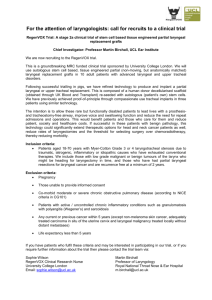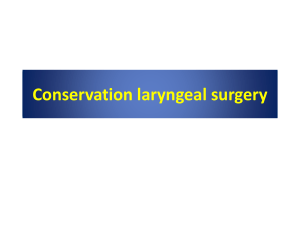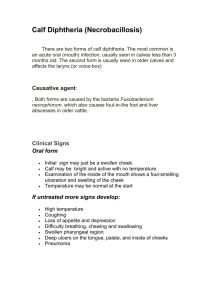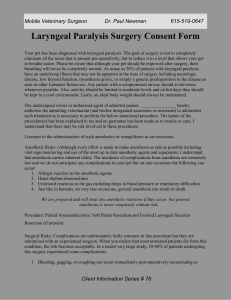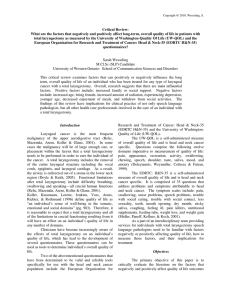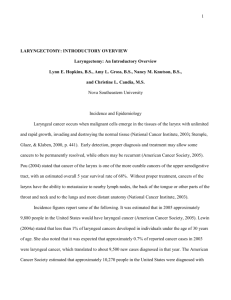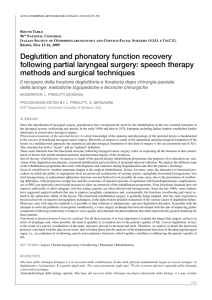Laryngology Seminar
advertisement
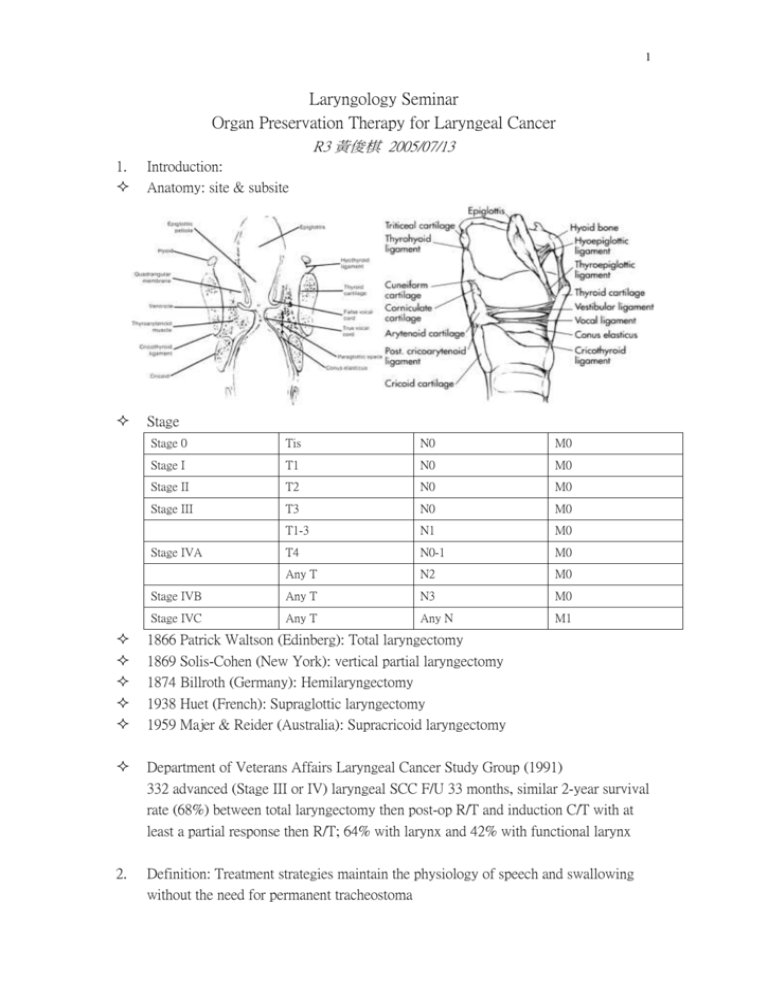
1 Laryngology Seminar Organ Preservation Therapy for Laryngeal Cancer R3 黃俊棋 2005/07/13 1. Introduction: Anatomy: site & subsite Stage Stage 0 Tis N0 M0 Stage I T1 N0 M0 Stage II T2 N0 M0 Stage III T3 N0 M0 T1-3 N1 M0 T4 N0-1 M0 Any T N2 M0 Stage IVB Any T N3 M0 Stage IVC Any T Any N M1 Stage IVA 1866 Patrick Waltson (Edinberg): Total laryngectomy 1869 Solis-Cohen (New York): vertical partial laryngectomy 1874 Billroth (Germany): Hemilaryngectomy 1938 Huet (French): Supraglottic laryngectomy 1959 Majer & Reider (Australia): Supracricoid laryngectomy Department of Veterans Affairs Laryngeal Cancer Study Group (1991) 332 advanced (Stage III or IV) laryngeal SCC F/U 33 months, similar 2-year survival rate (68%) between total laryngectomy then post-op R/T and induction C/T with at least a partial response then R/T; 64% with larynx and 42% with functional larynx 2. Definition: Treatment strategies maintain the physiology of speech and swallowing without the need for permanent tracheostoma 2 Medical organ preservation therapy Radiation & Surgery for early laryngeal cancer (T1,T2): NCDB 1995 Stage Management I Surgery 93 81 193 RT 90 73 678 surgery + RT 92 75 309 Surgery 82 57 70 RT 83 69 220 surgery + RT 87 70 75 II 5y -survival% Cases NEJM 2003: 547 patients stage III or IV F/U 3.8years Gr1: Induction CT + RT: local regional control 61%, laryngeal preservation 75% Gr 2:CCRT: local regional control 78%, laryngeal preservation 88% Gr3: RT alone=> local regional control 56%, laryngeal preservation 70% Similar 2 and 5 years overall survival rate: 74-76% and 54-56 % Surgical organ preservation therapy( Conservation laryngeal surgery) Principle of surgical organ preservation local control: most important, only when resection of tumor can be accomplished comfortably with local control rates approximating those of total laryngectomy 3. 2y-survival% predict extent of tumor: distinguish paraglottic space invasion caused fixed true vocal fold from tumor involved cricoarytenoid joint cricoarytenoid unit: consist of arytenoid cartilage, cricoarytenoid joint, posterior and lateral cricoarytenoid muscles, recurrent and superior laryngeal nerve eligibility for organ preservation surgery is base on extent of tumor, not T stage: T2 to cricoid level---no; T4 invade thyroid cartilage---yes Procedure Endoscopic cordectomy 3 carcinoma in situ or T1 without anterior commissure of glottis T1 glottic tumor: 142 cases, local control rate: 87.3% laser salvage: 6 (4.2%), total laryngectomy:3 (2.1%), RT:9 (6.3%) T1 glottic carcinoma: 34 cases local control rates 87.3% in laser therapy and 85.7% in radiotherapy 141 stage I supraglottic cancer: 5-year survival rate 85% Vertical partial laryngectomy(VPL) T1 glottic cancer without anterior commissure involvement T1a 5-years local failure rate: 0%~11% T2 5-years local failure rate: 4~26% T3 5-years local failure rate: > 30% Supraglottic laryngectomy ( SGL) T1 and T2 supraglottic cancer 4 19% survivors experienced a second respiratory tract primary within 5 years T1 and T2 5-years local filure rate: 0-15% Supracricoid laryngectomy (SCL) Cricohyoidoepiglottopexy (CHEP) cricohyoidopexy (CHP) selected T1b, T2, T3 and T4 laryngeal carcinoma and selected T1b and T2 radiation failures without subglottic extension (1mm) 62 T1b, T2 laryngeal cancer 5-years local control rates: 98.2% 112 T2, T3 laryngeal cancer 5-years local control rates: 94.6% overall local control rates: 66-100% 4. 23 T1/T2 recurrent irradiated glottic carcinoma 5-year local control rate: 66.6% Did the preserved organ really have function? Arch Otolaryngol Head And Neck Surg (1998) Stage III or IV, surgery + RT: 25 patients, CT + RT: 21 patients, 10.4 years 5 HNQOL Arch Otolaryngol Head And Neck Surg (2004) Stage III or IV, surgery + RT: 23 patients, CCRT: 19 patients, 15 months 5. Conclusion: Selection of eligible patients for which procedures is an art Balance between oncologic and functional outcome 6 6. Reference Tufano RP. Organ preservation surgery for laryngeal cancer. Otolaryngol Clin North Am. 2002 Oct;35(5):1067-80. The Department of Veterans Affairs Laryngeal Cancer Study Group. Induction chemotherapy plus radiation compared with surgery plus radiation in patients with advanced laryngeal cancer. N Engl J Med. 1991 Jun 13;324(24):1685-90. Forastiere AA, et al. Concurrent chemotherapy and radiotherapy for organ preservation in advanced laryngeal cancer. N Engl J Med. 2003 Nov 27;349(22):2091-8. Close LG. Cancer of the larynx: new approaches for organ preservation. Curr Surg. 2004 Sep-Oct;61(5):414-6. Moyer JS, et al. Current thoughts on the role of chemotherapy and radiation in advanced head and neck cancer. Curr Opin Otolaryngol Head Neck Surg. 2004 Apr;12(2):82-7. Yeager LB, et al. Organ preservation surgery for intermediate size (T2 and T3) laryngeal cancer. Otolaryngol Clin North Am. 2005 Feb;38(1):11-20, vii. Koch WM. Head and neck surgery in the era of organ preservation therapy. Semin Oncol. 2000 Aug;27(4 Suppl 8):5-12. Makeieff M, et al. Supracricoid partial laryngectomies after failure of radiation therapy. Laryngoscope. 2005 Feb;115(2):353-7. Terrell JE, et al. Long-term quality of life after treatment of laryngeal cancer. The Veterans Affairs Laryngeal Cancer Study Group. Arch Otolaryngol Head Neck Surg. 1998 Sep;124(9):964-71. Hanna E, et al. Quality of life for patients following total laryngectomy vs chemoradiation for laryngeal preservation. Arch Otolaryngol Head Neck Surg. 2004 Jul;130(7):875-9. Commings otolaryngology H&N Surg 3th edition chapter 114-115
